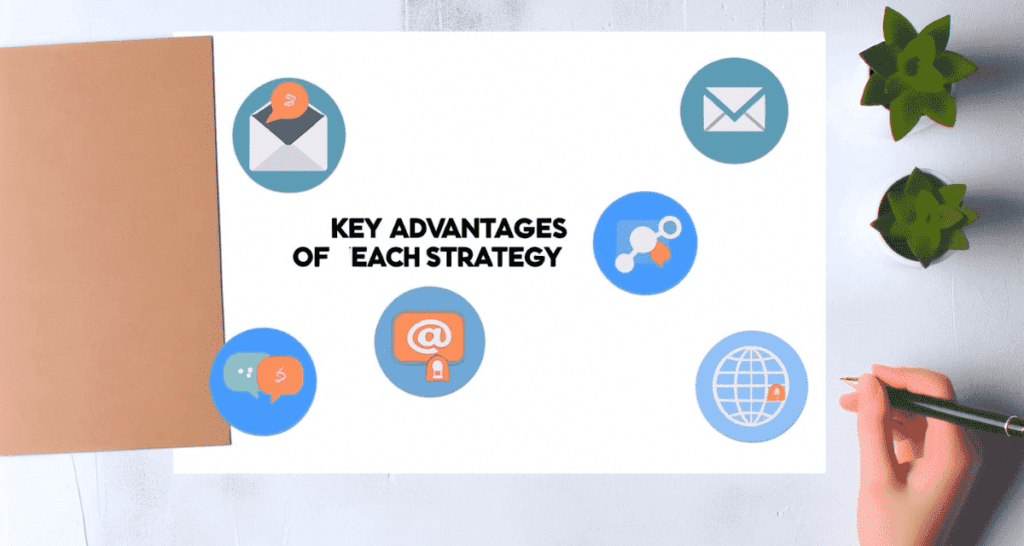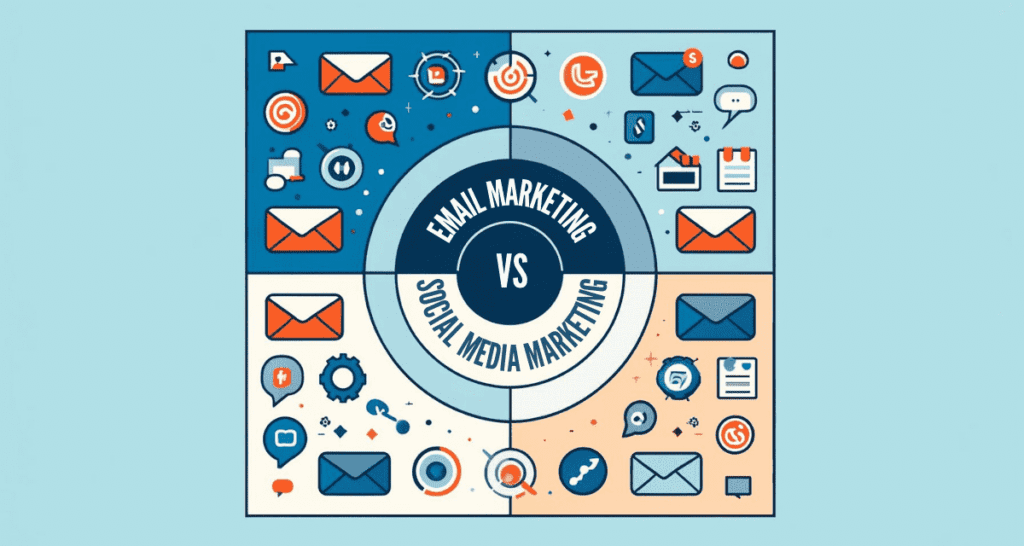Introduction
As we navigate the digital marketing landscape in 2024, understanding the strengths and limitations of various strategies is crucial. This article dives into two major players: email marketing and social media marketing, comparing their effectiveness, challenges, and best applications for different business types.
Defining the Strategies
Email Marketing Defined
Email marketing involves sending targeted messages directly to the inboxes of a curated list of recipients. It’s designed to nurture leads, build customer loyalty, and drive conversions through personalized communication.
Is Email Marketing Still Worth It in 2024?
Social Media Marketing Defined
Social media marketing exploits the power of platforms like Facebook, Instagram, and Twitter to promote brands, engage with customers, and drive traffic to websites or physical locations. It emphasizes creating content that resonates with a broad audience to encourage shares and interactions.
Key Advantages of Each Strategy

Advantages of Email Marketing
Personalization and Segmentation
Email marketing excels in its ability to deliver personalized content directly to individuals. Advanced tools allow marketers to segment their lists based on user behavior, preferences, and past purchases, enabling highly targeted campaigns that are more likely to resonate and convert.
Direct Access to Consumers
One of the most significant benefits of email marketing is the direct line it establishes to consumers. Emails land in users’ inboxes without the interference of algorithm changes, offering a consistent platform for communication.
Advantages of Social Media Marketing
Broad Reach and Engagement
Social media platforms offer access to vast audiences globally. The interactive nature of these platforms allows for real-time engagement with customers, fostering relationships and building community around a brand.
Real-time Communication
Social media enables instant communication, making it ideal for brand announcements, crisis management, and customer service interactions. This immediacy can enhance brand responsiveness and customer satisfaction.
Challenges and Limitations
Challenges of Email Marketing
Deliverability Issues
One major challenge in email marketing is ensuring that emails reach the recipient’s inbox and aren’t relegated to the spam folder. Factors such as sender reputation, email content, and user engagement significantly influence deliverability.
Over-saturation
With the average person receiving dozens of emails daily, inboxes have become highly competitive spaces. Standing out in a crowded inbox requires exceptional content and smart segmentation strategies.
Challenges of Social Media Marketing
Algorithm Changes
Social media platforms often update their algorithms, which can significantly impact visibility and engagement. Brands must continuously adapt their strategies to maintain their reach.
Dependency on Platform Rules and Policies
Marketing on social media means playing by the rules set by each platform, which can change unexpectedly. These changes can hinder marketing efforts or force a shift in strategy at a moment’s notice.
Comparative Analysis: Cost, ROI, and Conversion Rates
Cost Efficiency
Email Marketing: Generally, email marketing is recognized for its cost-effectiveness. The primary expenses are associated with email marketing platforms and list maintenance, which are relatively low compared to other advertising costs. This makes it a cost-effective option for businesses of all sizes.
Social Media Marketing: While organic social media marketing can be cost-effective, paid advertising costs can vary widely. The expenses depend on the campaign scale, target audience, and competition for ad space, which can make it more costly than email marketing.
ROI Analysis
Email Marketing: Email marketing often boasts a high return on investment due to its direct approach and personalized nature. According to data from the Direct Marketing Association, email marketing can offer an ROI of up to $42 for every dollar spent, making it one of the most efficient marketing strategies available.
Social Media Marketing: ROI for social media can be significant, especially when campaigns go viral. However, measuring the exact ROI can be more complex due to diverse engagement metrics (likes, shares, comments) and the indirect path to purchase.
Conversion Rates
Email Marketing: Typically, email marketing has higher conversion rates for direct sales, thanks to targeted messages that can be highly personalized and timed based on consumer behavior.
Social Media Marketing: Conversion rates for social media marketing tend to be lower compared to email, as social media is often more about brand engagement and awareness than direct sales. However, it is excellent for building the top of the sales funnel, which can indirectly contribute to conversions.
Who Should Use Which Strategy?

Suitability for Different Business Types
Start-ups and SMEs
Email Marketing: Start-ups and small to medium enterprises (SMEs) often benefit from email marketing due to its low cost and high ROI, allowing them to reach their audience directly without a large budget. It’s particularly effective for nurturing leads and converting them into loyal customers.
Social Media Marketing: SMEs can also leverage social media to build brand awareness and engage with a broader audience. Social media platforms offer a way to create viral content and interact with consumers in real-time, which can be invaluable for building brand identity quickly.
Large Corporations
Email Marketing: Large corporations use email marketing to maintain contact with their extensive customer bases. It’s an efficient tool for disseminating information, promoting new products, and personalized communication at scale.
Social Media Marketing: For large corporations, social media is crucial for maintaining public relations, customer service, and engaging with customers on a global scale. It supports a dynamic, interactive brand presence.
Industry-Specific Recommendations
Retail Industry
Email Marketing: Highly effective for promotional announcements, personalized offers, and retargeting efforts. Retailers can use email marketing to send targeted promotions based on past purchasing behavior, enhancing the likelihood of repeat purchases.
Social Media Marketing: Crucial for building brand loyalty and engaging with customers through user-generated content, reviews, and interactive posts. Social media platforms like Instagram and Pinterest are particularly beneficial for retailers due to their visual nature, which is ideal for showcasing products.
B2B Companies
Email Marketing: Essential for nurturing long-term relationships with clients and leads. B2B email campaigns often focus on providing valuable content such as whitepapers, case studies, and industry insights that help build credibility and establish thought leadership.
Social Media Marketing: LinkedIn is particularly effective for B2B companies. It allows businesses to establish professional connections, share industry-related content, and participate in discussions that enhance their standing in the business community.
How to Use LinkedIn to Find Social Media Marketing Clients.
Integration and Synergies
Combining email marketing and social media marketing can create a cohesive and powerful digital marketing strategy. Here’s how businesses can leverage the strengths of both to maximize their marketing efforts.
Integrating Email and Social Media Marketing
Cross-Promotion Techniques
Utilize social media to grow your email list by promoting sign-up incentives like exclusive content or special offers. Conversely, use email campaigns to encourage your subscribers to follow your social media pages, enhancing your engagement across platforms.
Unified Messaging
Ensure that your messaging is consistent across both email and social media platforms. This unified approach helps reinforce your brand identity and ensures a coherent customer experience, whether they’re reading an email or browsing through their social media feeds.
Conclusion
Synthesizing Key Insights
In our exploration of “Email Marketing vs. Social Media Marketing in 2024,” we’ve dissected the unique advantages, challenges, and optimal applications of both strategies within the modern marketing landscape. Each approach serves distinct purposes and offers different benefits to marketers, depending on their specific business goals, industry sectors, and target audiences.
Making Strategic Decisions
For businesses deciding between email marketing and social media marketing, or considering integrating both, it’s crucial to evaluate your specific needs and resources. Consider factors like your marketing budget, staff expertise, and the nature of your customer interactions. Reflect on the insights provided to determine which strategy—or combination of strategies—will most effectively meet your objectives.
Moving Forward
As we continue to navigate through 2024 and beyond, the key to success in digital marketing will lie in agility and informed decision-making. By staying abreast of emerging trends, continuously refining your methods, and embracing new technologies, you can ensure that your marketing efforts remain effective, responsive, and aligned with your business goals.
Author

Nate , our Author Extraordinaire, transforms ideas into literary masterpieces. Whether it's blog posts, articles, or captivating stories, he weaves a narrative that resonates and leaves a lasting impression.
View all posts







